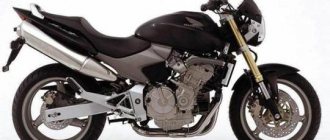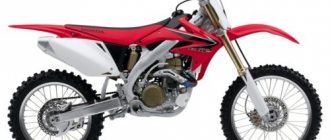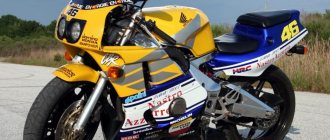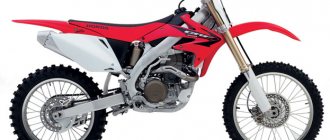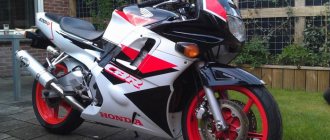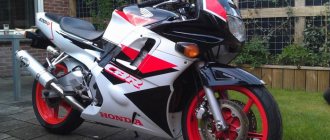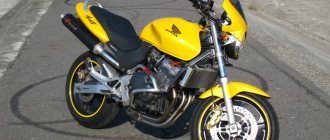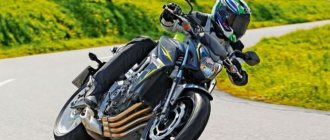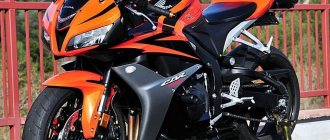What qualities should a motorcycle have for riding on rough terrain? Reliability, power, maneuverability... It’s difficult to compile a complete list. The developers of the Japanese company Honda realized that a motocross car has all the necessary qualities. Cross versions of the CR250R and enduro versions of the CR250M were produced.
The Honda CRM 250 model became an offshoot from the main line, but retained all the best qualities of the series - reliability, strength, durability.
Design of Honda CRM 250
The sports enduro Honda CRM 250 is considered one of the most successful models with a small engine capacity. In the photo is our correspondent Edik, who is also the owner of the motorcycle.
The representative of this solution was the CRM 250, an enduro with a steel frame, released in 1989 . Since it appeared on the assembly line later than the cross-country CR250R, many of the parameters of the models are identical. Electronic control, general rigidity of the structure, good traction at the top.
The motorcycle's exhaust pipe makes several bends before rising to the rear fender. Feels the power!
But the developers took into account that hardly anyone would race through the forests at maximum speed, so the new bike received less power, but equally good traction across the entire speed range. This contributed to increased reliability and durability.
Peculiarities
One of the parts inherited from its cross-country parent was the inverted front fork.
An inverted fork appeared on the motorcycle in 1991.
The first models (1989–1991) had a regular one, then it was replaced.
The first models were produced with a conventional telescopic fork.
The new version had a working stroke of 300 mm, increased energy intensity, and the ability to adjust the compression force. At the rear, a standard mono-shock absorber solution was used. Like the front fork, the compression force could be adjusted.
Air tank - needed to pump or bleed air in the rear shock absorber. Everyone can adjust the shock absorber stiffness for themselves, or for a specific type of driving.
Exterior
The traffic regulations are more loyal to enduro than to cross-country versions, so when creating the bike, the developers had to re-solve the issues of optics and mirrors.
At the same time, since the engine was also inherited, its alignment, location, and external design could not be touched.
Front end
Like many off-road motorcycles, the large front fender is raised almost to the frame.
- The front body kit is small, slightly curved forward. In the center there is a medium-sized round headlight. Under it there is a technological opening for the intake of cold air, which, thanks to the design of the frame, is directed to the engine radiator.
Headlight with a more powerful halogen lamp.
- The upper part of the body kit is crowned with a small windshield . Since racing is not typical for enduro, it is enough for a comfortable ride for a motorcyclist of average height. The turn signals are located above the center of the headlight, spaced on the fork legs.
- An interesting detail is the protection of the driver’s hands. In front of the control handles (already in the basic configuration) there are “wings” made of square-shaped plastic. According to users, it seems to be more correct to make small aerodynamic pads, but the size of the preset option can cover even the largest hands.
The plastic “wings” are painted to match the main color of the motorcycle.
- The mirrors are round and widely spaced . There are a minimum of settings, since the mounting part is motionless. According to some users, this is a minus, since part of the view is blocked by the driver’s shoulder and you have to constantly bend down. The steering wheel is also stationary - no settings are provided. Tall drivers will need to get used to a purely sporty, forward-leaning seating position.
Dashboard
The minimalism of this block has also come from its prototype, a motocross bike.
Most of the dashboard is occupied by a mechanical speedometer.
The driver has access to speed readings and total mileage since the start of use. All other necessary data is represented by indicator lamps. There is no fuel indicator among them; the driver is asked to decide on the reserve and consumption independently.
A large number of metal pipes around and below the speedometer give the panel a sharp, masculine look . Some confusion is caused by the bend of the upper tube forward, towards the windshield. The developers commented on this as additional protection for the driver from threats ahead. The glass will break, but the tube will stand.
The steering wheel on the bike is simple and reliable.
Depending on the year of manufacture, mirrors may be missing.
Rear end
The design of the optics here depends on the year of manufacture. The first motorcycles had a sharp body kit.
On the first models there were no rear optics at all. The photo shows our editorial 125 Kayo and Honda CRM 250.
Neither headlights nor a mudguard were provided. The muffler pipe was located almost above the rear wheel. In newer editions, the pipe was moved to the left, and a short mudguard was connected to the rear of the frame. The rear marker is located on it. The factory design does not provide for a stop, but the glass is large - you can install it next to it or use a double-spiral. There are no rear turn indicators.
The rear light was mounted on the fender, and many people installed the turn signals themselves.
The CRM 250 is a typical motorcycle for one . The driver's saddle is traditionally in the recess in the middle part of the frame, but it is short, there is no way for two to sit.
The seat is quite comfortable, and if you need to go, you can go as far as necessary. Edik is happy!
There is an extension of the frame behind the driver, but it is not intended for landing. There is a muffler nearby.
The frame design does not provide space for a passenger seat. This is a motorcycle for one!
The difference from many motorcycles of another class is the minimum possible width size. Because of this, the gas tank is placed “on edge”, which makes it look quite small in appearance and does not stand out much from the overall design.
Gas tank
The narrow and high gas tank provides the driver with a seat as close as possible to the steering wheel.
The protruding neck cover is pressed as closely as possible to the instrument unit. According to the developers, it is no less than that of its competitors.
You can pour 10 liters into it.
Reviews
Reviews of Honda CRM250:
Expand Collapse
I recently bought myself a glass =) I’m head over heels happy. Among the minuses, a slight vibration was noticed at 100-120+ mph (the large star has 53 teeth, instead of the standard 42) and simply unrealistic gasoline consumption. Due to the lack of a speedometer drive, I don’t know exactly, but it looks like 8 liters per hundred. So far I’ve only tested it in the city, I won’t climb into the hard pampas - the wheels are Motard 17e. But I plan to climb into forests and primers soon and test =)
Honda CRM 250 AR - this was a good reason to sell my XR650R, which I thought was forever! CRM 250 AR is a technical delicacy for real gourmets. A rigid CR chassis and a two-faced engine with the characteristics of the 250 XR at the bottom and the pick-up of the 650 at the top. Separately, about the sound of a two-stroke engine - this is a hymn to the 80s, when we, as boys in dachas and villages, dreamed and could not fall asleep at night listening to the sounds of Izhas and Javas passing by our windows.
CRM 250 AR is not suitable for phlegmatic people and beginners. The two-stroke does not like “nausea” at stable medium speeds. The theme is constantly opening the throttle and braking. By the way, about braking, you won’t be able to brake with the engine; you need to use the brakes in the classic cross-country style. I used it to climb into serious swamps with ruts of 70 cm, it’s unclear what kind of equipment it was from. Low-end traction is excellent, starting from idle (springs 14 to 49), no need to use the clutch. All the more powerful equipment (400, 650) in such conditions is almost immediately dug in to the very hubs, after which those who are lighter have a great opportunity to relax, watching the fascinating process of pulling “monsters” out of the swamp (and as you know, this is not an easy job). The moment of forcing lying logs, in a swamp or forest, is very interesting: idle - release the clutch - gas - we fly over the log - YES! The coolest thing about this motorcycle is that it can be started with a kick starter; it is so easy that this procedure can be done while wearing beach slippers. Starting in cold weather also with half a kick. The name AR translates as activated radicals. This motorcycle uses unique technical solutions, which even today, if anyone makes them, they do so in a very simplified form.
Cons: I did find one big drawback - when crawling for a long time and leisurely in the “shit,” the engine overheating light quickly lights up and traction slowly begins to disappear. The same topic was noticed on the CRM of a friend who had the misfortune of being nearby. I’m thinking of solving this problem by installing an electric fan, since there is space behind the left radiator. There is another scary problem: every ride on the Honda XR650R was like a hard workout in a gym for all muscle groups, followed by washing the sweaty equipment. On the CRM 250 AR on the same routes I don’t get tired at all, as if it does everything for me. So a trip to the nearest gym is just around the corner.
Huge respect to the designers for free access to the spark plug; to replace it, you do not need to remove the tank and seats. In constantly discovering something new in motorcycles, the CRM 250 AR proved to be a real boost. I revel in its lightness, the rigidity of the chassis, and the cheerful pickup. I am convinced that among the universal hard enduro bikes that are approved for public roads (licensing vehicle, turn signals, headlights and brake lights), unfortunately, there is no equal to the CRM 250 AR.
If you want both agility and rare service, then CRM is the best option. Air 250s don’t run after it, CRF-X seems like cross-country bikes in terms of service intervals 
But you need to get used to the way she drives. The R and AR are very different, both in suspension and engine. If closer to '00, then it's AR. It was released from 97 to 99.
If the oil level is not too low, the piston will last for a long time. But you still need to keep an eye on the cleanliness of the power valve, otherwise your brains will burn out. And the balancing shaft may die. That's the problem with him, it's difficult to find. Otherwise, the spendthrift is just garbage.
Power point
Since the engine is 2-stroke, the owner needed to periodically add oil. For this purpose, the bike was equipped with an oil tank with its own pump.
At the top right is a plastic cover for the oil pump, which can be damaged if dropped badly. Therefore, it is necessary to regularly inspect its integrity.
In the corner of the speedometer there was a light bulb familiar to all owners of 2-stroke vehicles. If it flares up, you need to add oil .
The bike received a 2-stroke, 1-cylinder cross version engine, which was slightly redesigned for use in Enduro:
- working volume - 247 cm3;
- power - 41 hp;
- number of valves - 2;
- cooling - liquid;
- fuel supply - carburetor;
- ignition - electronic;
- start - via kick starter leg;
- fuel tank - 10 (in the latest models 11) l.
Starting the engine on CRM 250
Despite the fact that the main start in motorcycle style is by pressing the foot, there is a button on the steering wheel. Starting the engine is carried out in three steps.
- Ignition.
- Pressing the starter button.
- Start by pedal.
Between the second and third, the developers recommend pausing for a second or a half. According to user comments, the button in the second step does not turn on the engine, but the oil supply pump . That is why the pause between stages is insignificant, and pressing the button requires starting the engine.
The 3-speed system made it possible to start the engine without problems in any weather conditions, even in cold winters.
Tips for choosing
According to the owners' reviews, the motorcycle is worthy of attention. It is reliable, and in terms of acceleration and handling it is not inferior to modern soft enduros. But due to problems with spare parts, look for the CPM 250 initially in good technical condition. And you will ride for a long time without problems and headaches.
Suitable for both beginners and experienced riders who want to switch to a more powerful enduro and try something new.
I recommend watching this video:
Transmission and clutch
The bike received a gearbox from its cross-country parent, but the developers carefully rebuilt the gearbox, reducing the gear travel.
For more balanced traction, the gear ratios were reconfigured . The work did not go unnoticed - users are satisfied with the box. It works according to the standard sequential type - 6 steps + neutral .
Drive unit
Chain drive.
The exposed chain drive requires regular cleaning and lubrication. Some people make homemade rubber “wings”. But here you have to be very careful so that when you fall, the “protection” does not get caught in the chain!
As an experiment, the developers used a belt drive in several batches, but then all versions were withdrawn from the market. According to the warranty conditions, a chain was installed on the models.
Multi-disc clutch, oil frame . According to experts, Honda more often uses another option, with a dry sump. But here the developers took into account all the features of the engine and installed a standard design.
Brakes
Front brakes.
Rear brakes.
Over the entire 10 years of production of this model, the brake system has undergone only 1 change.
Initially, the motorcycle was equipped with a disc version with hydraulic drive on both axles. The diameter of the disks varied.
Then, to reduce cost and ease of maintenance, identical disks began to be installed on both axles.
Front brakes:
- number of disks - 1;
- diameter - 260 (since 1991 - 240) mm;
- support - 2.
Rear brakes:
- number of disks - 1;
- diameter - 240 mm;
- support - 1.
Exploitation
Buyers needed to be clear about where they would use the bike.
If it's mainly off-road conditions, the choice was ideal.
The Honda CRM 250 is absolutely not suitable for quiet and long driving on asphalt. If only because the tires here are cross-country.
In cases where you plan to drive on asphalt or compacted dirt roads with occasional off-road trips, you had to seriously think about the need to purchase this version. The developers went too far in adjusting the front brake support, so the front brake worked worse on asphalt than off-road.
Appearance
The Honda CRM 250 looks very similar to a cross-country vehicle. In a word, a typical enduro. You can feel, however, the weight, and the fact that this model will definitely cope with off-road conditions. There are no special frills in the design. It's brutal and shows the tough nature of the bike and the fact that it can overcome a lot.
One review says that this bike has a unique design. But it is possible to agree with this only regarding the colors. The last two years' version features a striking appearance with a funky combination of white, black and red colors, as well as an orange flame design on a black background. However, many connoisseurs of class, judging by the photo and even the description, say that they would like more modesty in the design.
Driving performance
Despite its kinship with a cross-country shoe, the maximum speed is low and amounts to 140 km/h.
According to experts, the concern's engineers are “obsessed” with safety. The cross version had the same engine, but it was boosted for racing. As a result, the difference in maximum speed between the bikes is only 10 km. The cross-country vehicle has 150 km/h .
Acceleration to hundreds
Acceleration to 100 km is not impressive - 8 seconds, but you need to remember that to increase reliability and durability, the engine characteristics were artificially lowered.
Fuel consumption
The model also owes its kinship to cross-country racing to its fuel consumption.
The user needs to be prepared for figures of 6–8 liters per 100 km.
Price range
In terms of price, few can compare with Honda CRM. Its cost in Russia starts from 30,000 rubles. The upper limit fluctuates around two hundred thousand. What causes such a big difference between the numbers? First of all, of course, on the condition of the bikes. If you bought yourself an enduro for 50 thousand rubles, be prepared to invest twice as much into it. Motorcycles are often sold for next to nothing by those who are tired of tinkering with them. Old vehicles sometimes turn into a real “black hole” for money and require more and more new investments.
To avoid getting into trouble and not wasting all your money on repairs, be careful when purchasing. It will be best if you have the opportunity to inspect and test the motorcycle. If they are not for sale in your city, buy only from trusted people, and first ask them to record and send you a video of the bike being inspected “live.” No sane person would sell a good bike for next to nothing. Here everyone needs to decide what they like best: invest their money and time in a “killed” sample or buy a motorcycle immediately ready for long trips. Be that as it may, the Honda CRM 250R remains one of the most budget-friendly means of transportation on two wheels.
Dimensions and weight
The motorcycle can be called very light - its curb weight is 125 kg.
With the exception of the narrow width, which immediately distinguishes representatives of the enduro class, the Honda CRM 250 in external parameters is not much different from motorcycles of other classes - cruiser or tourist. The bike has:
- in length - 2180 mm ;
- width - 685 mm ;
- height - 1033 mm ;
- on the saddle - 860 mm .
It is impossible not to note the perfect balancing. Even though the saddle is located high, the motorcycle is comfortable to ride for people of any height, from giants to dwarfs.
If a motorcyclist does not reach the ground with his feet at a stop, the bike can be tilted without fear of dropping . Balancing is also felt well when turning or overcoming obstacles. An experienced rider should not be afraid that when entering a turn or jumping over a log, the rear wheel will skid.
Comfort
Judging by the reviews, the ride is comfortable, but you shouldn’t drive into too impassable mud. At the very least, you should not travel far through such territory from a more or less dry area. Otherwise, the bike may start to lose power in the middle of such a “sea”, and this will be a problem.
Looking at the photo and even the video, it is possible to assume that sitting in such a car is uncomfortable. The motorcycle seems narrow. But the saddle here is both wider and more comfortable than on cross-country equipment. Of course, this car cannot be compared with road vehicles, much less with cruisers. But for enduro the landing is comfortable. Maintenance is not difficult, although parts can be difficult to obtain.
Comparison with Enduro
Copying each other's designs is almost a rule of good manners.
But sometimes this leads to the user standing in front of two identical motorcycles, not knowing which to choose. Externally identical, at first glance the differences are only in color and model name.
Honda CRM 250 has two such “identical” ones:
- Suzuki RMX 250.
- Kawasaki KDX 250.
Suzuki RMX 250.
Kawasaki KDX 250.
Therefore, below, in the form of a list, the main differences between all three models will be presented. Parameter, then values for Honda, second for Suzuki, last for Kawasaki:
- weight (dry) — 125, 112, 107;
- cylinder diameter — 66.4, 66.4, 67;
- working stroke — 72, 71, 70;
- start - kick starter + button; kick starter, button;
- front brakes - discs with a diameter of 240, 250, 240;
- gas tank capacity — 10, 11, 11;
- last year of release — 1999, 2004, 1993;
- price (with mileage in the Russian Federation) — 117 000, 120 000, 100 000.
There is no point in listing the remaining parameters - they are the same for all three presented models.
There is information that Kawasaki's first generation models had drum brakes, and it achieved operating power at lower speeds.
Brief history of the model
- 1989 - start of production and sales. The first generation is MK1
.
Model
: Honda CRM250 (Japan).
Frame number:
MD24-100XXXX.
Factory designation:
CRM250R.
- 1990 - no significant changes.
Model
: Honda CRM250 (Japan).
Factory designation:
CRM250R.
- 1991 - restyling of the model. Second generation - MK2
.
Model
: Honda CRM250 (Japan).
Frame number:
MD24-120XXXX, MD24-130XXXX.
Factory designation:
CRM250R.
- 1992 - no significant changes.
Model
: Honda CRM250 (Japan).
Factory designation:
CRM250R.
- 1993 - minor changes to the model. Starting this year, the wings and saddle are painted the same color.
Model
: Honda CRM250 (Japan).
Factory designation:
CRM250R.
- 1994 - restyling of the model. Third generation - MK3
.
Model
: Honda CRM250 (Japan).
Frame number:
MD24-140XXXX.
Factory designation:
CRM250R.
- 1995 - no significant changes.
Model
: Honda CRM250 (Japan).
Factory designation:
CRM250R.
- 1996 - no significant changes.
Model
: Honda CRM250 (Japan).
Factory designation:
CRM250R.
- 1997 - restyling of the model. New generation - Honda CRM250AR
.
Model
: Honda CRM250AR (Japan).
Frame number:
MD32-100ХХХХ, MD32-110ХХХХ.
Factory designation:
CRM250AR.
- 1998 - no significant changes.
Model
: Honda CRM250AR (Japan).
Factory designation:
CRM250AR.
- 1999 is the last year of production.
Model
: Honda CRM250AR (Japan).
Factory designation:
CRM250AR.
Disadvantages of Honda CRM 250
Unfortunately, the model has disadvantages, but almost all of them belong to the light enduro class, and not specifically to Honda.
Among them:
- lack of motor protection — a jump on sharp stones can result in breaking through the crankcase cap, so many owners finish this part themselves;
Protection would be most welcome here.
- high fuel consumption;
- difficulties in finding individual parts (but it is possible to use them from other models of the brand);
- The tight layout requires disassembling the bike to the ground even with the most minor faults.
At the same time, the quality of the brand neutralizes the last two minuses.
Advantages
The bike has more advantages:
- ergonomic fit - despite its similarity to a cross-country shoe, it is comfortable to sit;
- A reliable frame that allows you to overcome any obstacles and has a good margin of safety;
- power reserve;
- redesigned rear suspension;
The rigid rear shock absorber withstands many hours of shaking over rough terrain.
- large front suspension travel;
- ease of control (for people of any height);
- Thanks to the low compression ratio, the engine lasts longer.
Affordability and reliability
The CPM 250r was produced in the 90s and in terms of characteristics it is inferior to modern European enduro models, which are lightweight to the maximum, have an injection engine and customizable suspensions for any rider. But the old SRM 250 has its own huge advantage - it is very reliable, first of all. And secondly, it is inexpensive - for the price of a trouble-free Honda CRM250R you cannot buy modern KTM, Beta or Husqvarna enduros, which cost several times more.
